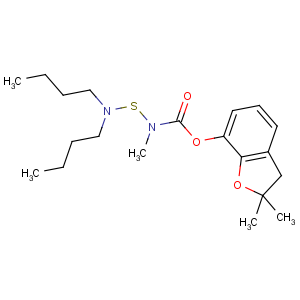Title: Carbosulfan
CAS Registry Number: 55285-14-8
CAS Name: [(Dibutylamino)thio]methylcarbamic acid 2,3-dihydro-2,2-dimethyl-7-benzofuranyl ester
Manufacturers' Codes: FMC-35001
Trademarks: Marshal (FMC); Posse (FMC)
Molecular Formula: C20H32N2O3S
Molecular Weight: 380.54
Percent Composition: C 63.12%, H 8.48%, N 7.36%, O 12.61%, S 8.43%
Literature References: Carbamate cholinesterase inhibitor which is hydrolyzed to carbofuran in soil. Prepn: A. L. Black, T. R. Fukuto,
BE 817517;
eidem, US 4006231 (1975, 1977 both to Regents Univ. Calif.). Metabolism in orange tree leaves and fruit: V. E. Clay, T. R. Fukuto,
Arch. Environ. Contam. Toxicol. 13, 53 (1984). Degradation and persistence in soil: A. Sahoo
et al., Bull. Environ. Contam. Toxicol. 50, 29 (1993). HPLC determn in oranges: M.W. Brooks, A. Barros,
Analyst 120, 2479 (1995). Spectrophotometric determn in formulations and water samples: K. R. Mohan
et al., Asian J. Chem. 10, 457 (1998). Review of physical properties and field trials: E. G. Maitlen, N. A. Sladen,
Proc. Br. Crop Prot. Conf. - Pests Dis. 1979, 557-564.
Properties: Viscous, brown liquid. Soly in water at 25°: 0.3 ppm. Soly in organic solvents: > 50%. Vapor pressure: 0.31 ′ 10-6 mmHg. LD50 in male, female rats (mg/kg): 250, 185 orally; in male, female rabbits (mg/kg): >2000, >2000 dermally; in pheasant, mallard, quail (ppm): 26.2, 8.1, 81.6 orally. LC50 (96 hr) in bluegill, trout (ppb): 14.9, 42.4 (Maitlen).
Toxicity data: LD50 in male, female rats (mg/kg): 250, 185 orally; in male, female rabbits (mg/kg): >2000, >2000 dermally; in pheasant, mallard, quail (ppm): 26.2, 8.1, 81.6 orally. LC50 (96 hr) in bluegill, trout (ppb): 14.9, 42.4 (Maitlen).
Use: Insecticide.

